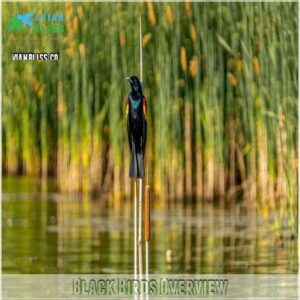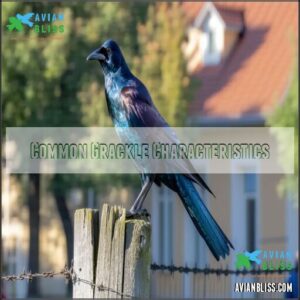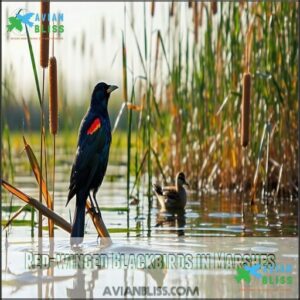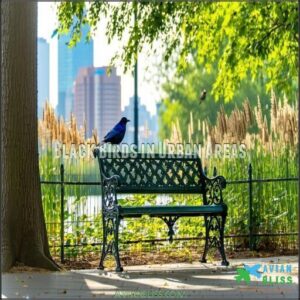This site is supported by our readers. We may earn a commission, at no cost to you, if you purchase through links.

You’ll spot the red-winged blackbird, often in wetlands, showing off bright red and yellow shoulder patches.
The common grackle, with its glossy, rainbow-like sheen, struts through city streets and fields like it owns the place.
Starlings, though not native, are everywhere, chattering in huge flocks.
Cowbirds might pull a parenting trick, leaving their eggs in other birds’ nests.
From crows with their booming calls to the night-loving black-crowned night heron, Ohio’s skies are full of character.
Curious what makes them all so unique? Their stories might surprise you!
Table Of Contents
- Key Takeaways
- Black Birds Overview
- Black Birds Identification
- Black Birds Habitats
- Black Birds Behavior
- Black Birds Conservation
- Frequently Asked Questions (FAQs)
- What black birds are common in Ohio?
- What does it mean when your yard is full of blackbirds?
- What is a black bird that is not a crow?
- Are blackbirds common in Ohio?
- What do blackbirds look like in Ohio?
- Are yellow-headed blackbirds common in Ohio?
- Is there a more beautiful black bird in Ohio?
- Where do red winged blackbirds live in Ohio?
- Why are blackbirds declining in Ohio?
- Why is my yard full of blackbirds?
- Conclusion
Key Takeaways
- You’ll spot black birds like Red-winged Blackbirds and Common Grackles thriving in Ohio’s wetlands, fields, and backyards.
- Red-winged Blackbirds stand out with flashy red and yellow shoulder patches, while Common Grackles shimmer with iridescent blue and purple feathers.
- Habitat loss, like shrinking wetlands and urbanization, is a major reason behind the decline of black bird populations in Ohio.
- Protect black birds by supporting wetland conservation, planting native greenery, and reducing pesticide use to help their habitats thrive.
Black Birds Overview
You’ll find black birds to be some of the most fascinating species in Ohio, with their bold behaviors and striking appearances.
From the loud Red-winged Blackbird to the iridescent Common Grackle, these birds bring life to wetlands, forests, and even your backyard.
Blackbird Family Diversity
Within the Icteridae family, blackbirds stand out for their vibrant Icteridae variations, from dazzling plumage differences to distinct vocalizations.
They occupy diverse habitats—from marshes to forests—across Ohio. Migratory habits make species like the Common Grackle and the Red-winged Blackbird adaptable year-round.
This variety guarantees Ohio’s wetlands and grasslands are alive with color and sound, especially during migration seasons! Some species exhibit distinctive beak shapes useful for identification.
Red-winged Blackbird Species
The Red-winged Blackbird, a among black birds in Ohio, stands out with its vibrant red and yellow shoulder patches.
Found in wetlands and grasslands, these Ohio birds are known for their wetland roosts and bold mating strategies.
- Key Details:
- Belongs to the Icteridae family.
- Vibrant male plumage, streaked females.
- Diet: seeds, insects.
- Migratory, thrives in Ohio’s marshes.
- Regional variations enhance interest.
Common Grackle Species
The Common Grackle stands out among Ohio birds with its iridescent plumage shimmering in blues and purples.
Larger than most black birds, this species thrives in diverse habitats, adapting with an omnivorous diet.
Known for loud grackle vocalizations and social behavior, they often nest in colonies.
Variations, or grackle races, display subtle differences in plumage, making black bird identification fascinating.
Black Birds Identification
You’ll spot black birds across Ohio, but identifying them takes careful observation of their size, markings, and behavior.
Focus on key traits like wing color, beak shape, and vocalizations to tell species apart confidently.
Red-winged Blackbird Features
Did you know male red-winged blackbirds proudly flaunt black plumage with bold red and yellow shoulder patches?
Females, however, rely on streaked brown feathers for camouflage, often blending into marsh vegetation.
These black songbirds, common in Ohio, captivate with their distinct vocalizations and nesting habits. Regional variations exist, but their flashy males and subtle females make them unforgettable among black birds Ohio hosts.
Common Grackle Characteristics
Grackles stand out among black birds thanks to their glossy plumage with striking blue-purple iridescence.
You’ll spot their lanky build, long tail, and sharp bill. Grackle vocalizations are loud and metallic, almost like a rusty hinge.
This Common Grackle varies by region—check out bronzed or purple races.
Their varied diet and adaptable behaviors make them clever survivors in diverse habitats. They’re known to thrive in diverse urban environments.
Other Black Bird Species
Ohio’s common black birds include fascinating species beyond grackles and red-wings.
Keep an eye out for:
- Rusty Blackbirds, with winter plumage and a love for wet leaves.
- Brown-headed Cowbirds, known for unusual cowbird behavior, often mingling in flocks.
- European Starlings, invasive and flashy, often confused with native species.
Each brings unique traits to your black bird sightings!
Black Birds Habitats
You’ll find black birds in a variety of habitats across Ohio, from marshy wetlands to bustling urban areas.
Each species thrives in different environments, shaped by factors like food availability and nesting sites.
Red-winged Blackbirds in Marshes
Step into Ohio’s marshes and discover the Red-winged Blackbird, a striking ambassador of wetland conservation.
Males, with their vivid red epaulets, fiercely defend nesting spots.
Females, camouflaged among cattails, craft nests that blend into marsh ecology.
These blackbirds thrive in wetlands, showcasing regional variations and nesting habits.
Every heaving call echoes their territorial flair, celebrating nature’s resilience.
Common Grackles in Various Habitats
Common Grackles are adaptable blackbirds thriving in Ohio’s diverse habitats.
These sleek, black plumage birds are frequently spotted in wetlands, farmlands, and forests. You’ll notice their nesting colonies, especially near water.
Their plumage shimmers with iridescent colors in the sunlight.
Here’s why they stand out:
- Urban Grackles adapt well to cities.
- Wetland Grackles nest near marshes.
- Grackle Diet includes seeds, insects, and grains.
- Grackle Migration flocks form in autumn.
Black Birds in Urban Areas
City streets and parks aren’t just for crows. Urban adaptation allows black plumage birds like Red-winged Blackbirds and Common Grackles to thrive.
You’ll spot these backyard birds in Ohio, enjoying feeders or perched in trees with city birdsong. Human interaction suits them, as nesting locations like shrubs and rooftops mimic marshy habitats.
These types of black birds prove resilient in any black bird habitat! Many bird enthusiasts find black bird seed online to attract these beautiful birds.
Black Birds Behavior
You’ll notice black birds in Ohio are anything but boring, with behaviors that reveal their intelligence and adaptability.
From complex mating rituals to clever foraging techniques, these birds thrive in diverse environments year-round, showcasing their adaptability.
Red-winged Blackbird Mating Habits
Male red-winged blackbirds are relentless in terms of attracting mates. They perch high, fluff their vibrant epaulets, and perform bold territorial displays.
Females, meanwhile, carefully assess nesting success potential and occasionally engage in extra-pair mating to boost genetic diversity. Male polygyny often means one redwinged blackbird may guard multiple females and nests, showcasing remarkable bird behavior.
They’re commonly found in North American wetlands, thriving in areas like cattail marshes.
- Key behaviors: Epaulet flashing, loud songs, aerial defense.
- Female traits: Selective, brown-streaked plumage aids nesting.
- Breeding spots: Dense cattails, wet marsh plants.
Common Grackle Social Behavior
Grackles’ flocking dynamics are fascinating.
These blackbirds often congregate in tight groups, showcasing colonial nesting and unique bird behavior patterns.
Their social hierarchy, marked by subtle communication signals, keeps order while cooperative foraging strengthens bonds.
Watching a grackle “debate” over food is like a bird boardroom meeting—chaotic yet efficient!
| Behavior | Description |
|---|---|
| Flocking Dynamics | Large, tight-knit groups for safety and foraging |
| Social Hierarchy | Dominance established through vocalizations |
| Colonial Nesting | Nests built near others, ensuring collective safety |
| Communication | Complex calls signal warnings or food locations |
Black Birds Foraging Habits
You’ll notice blackbirds adapting their bird feeding habits with impressive Dietary Diversity.
Seasonal Changes affect their Foraging Locations, from wetlands to suburban yards.
Food Competition is high, especially in urban adaptations, where they scavenge seeds, insects, and scraps.
Ohio’s bird species rely on varied bird habitats, showcasing clever bird behavior in Ohio as they search for their next meal in different Foraging Locations.
Black Birds Conservation
You can help protect Ohio’s black bird populations by understanding the challenges they face, like habitat loss and declining numbers.
By supporting conservation efforts and preserving wetlands, you’re ensuring these familiar birds remain a part of local ecosystems for generations.
Red-winged Blackbird Population Decline
Habitat loss, climate change, and agricultural impact are taking a toll on Red-winged Blackbird populations.
Habitat loss and climate challenges threaten Red-winged Blackbirds, urging action to protect Ohio’s wetlands and secure their vibrant future.
Modern farming practices, pesticide use, and shrinking wetlands disrupt migration patterns and nesting sites, triggering a steady bird population decline.
Despite being Ohio’s most abundant bird, they’ve seen a 53% drop since 1966.
Bird conservation efforts must confront these challenges to protect this iconic species, and address the issue of habitat loss.
Protecting Black Bird Habitats
Protecting blackbird habitats in Ohio is critical for their survival.
Here’s how you can help:
- Support wetland preservation to safeguard breeding areas.
- Advocate for habitat restoration to counteract urban and agricultural impact.
- Plant native greenery in urban habitats for nesting and foraging.
- Educate others about climate change’s effect on bird habitats.
- Volunteer with organizations promoting wetland conservation efforts.
You can also support Ohio wetland conservation through various avenues.
Conservation Efforts in Ohio
Wetland protection and habitat restoration are cornerstones of bird conservation in Ohio.
Efforts include population monitoring and reducing threats to bird species in Ohio, especially in critical bird habitats.
Public awareness campaigns highlight the need for preserving bird populations in Ohio, and partnerships and donations keep bird conservation efforts in Ohio alive.
Ensuring diverse bird habitats thrive for future generations is crucial, with bird conservation and habitat restoration being key to this goal.
Frequently Asked Questions (FAQs)
What black birds are common in Ohio?
Ohio’s standout black birds include the flashy Red-winged Blackbird with its red epaulets, the iridescent Common Grackle, and the noisy American Crow.
These feathered characters thrive in wetlands, fields, and suburban backyards across the state.
What does it mean when your yard is full of blackbirds?
When your yard’s swarming with blackbirds, it likely means they’re foraging during migration or gathering for food and shelter.
It’s nature’s way of giving you a front-row seat to seasonal bird behavior.
What is a black bird that is not a crow?
A black bird that isn’t a crow could be a Common Grackle or a Red-winged Blackbird.
Both flaunt unique looks—Grackles shimmer with iridescence, while Red-wings sport bold red-yellow shoulder patches.
Recognize them easily!
Are blackbirds common in Ohio?
Like leaves in autumn, blackbirds are everywhere in Ohio.
You’ll spot them in marshes, fields, and even neighborhoods.
Red-winged blackbirds and grackles dominate, making Ohio a hotspot for these fascinating and abundant species.
What do blackbirds look like in Ohio?
You’ll notice blackbirds in Ohio come in various styles—Red-winged males sport flashy red-and-yellow shoulder patches, while females blend with streaky brown feathers.
Common Grackles flaunt glossy, iridescent plumage, and their appearances are striking yet practical!
Are yellow-headed blackbirds common in Ohio?
Yellow-headed blackbirds aren’t common in Ohio, but they do pass through during migration.
You’re more likely to spot them in western wetlands—watch for their striking yellow heads and sharp calls, especially in spring or fall.
Is there a more beautiful black bird in Ohio?
You might admire the vibrant iridescence of the Common Grackle.
With its shimmering blue and purple feathers and bold behavior, it stands out as one of Ohio’s most striking birds—nature’s take on a living jewel.
Where do red winged blackbirds live in Ohio?
Home is where the marsh is!
Red-winged blackbirds thrive in Ohio’s wetlands, marshes, and grassy fields, often perched on cattails or shrubs.
You’ll even spot them near water, roadside ditches, and suburban feeders, particularly in areas with wetlands.
Why are blackbirds declining in Ohio?
Blackbirds in Ohio are declining due to habitat loss, especially wetlands, and changes in agricultural practices.
Pesticides, climate shifts, and urban development also threaten their populations, impacting food sources, nesting areas, and overall survival rates.
Why is my yard full of blackbirds?
Your yard’s likely full of blackbirds because they’re foraging for seeds, insects, or food scraps.
It’s migration season, and large flocks often gather for easier feeding and safety in numbers during their travels.
Conclusion
Imagine this: you’re by a marsh, spotting the bright shoulders of a red-winged blackbird while a grackle’s iridescent feathers shimmer nearby.
Ohio is home to a fascinating variety of black birds, each with unique traits that make identification a rewarding challenge.
From wetlands to city streets, these birds thrive in diverse habitats, showcasing intriguing behaviors like cowbirds’ nesting tricks.
Exploring black birds in Ohio reveals the beauty of these often-overlooked species—and they’re closer than you think, in a variety of habitats that support a range of species, including those with iridescent feathers.












